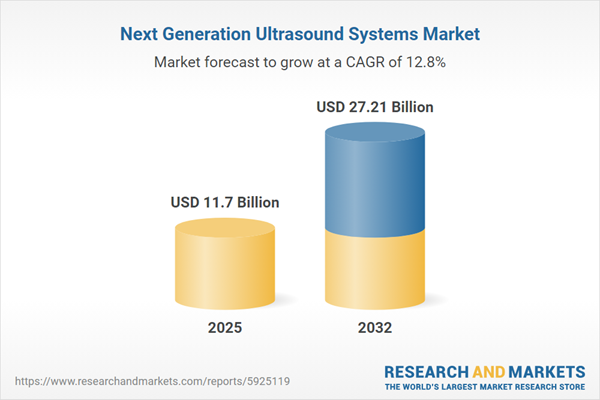Speak directly to the analyst to clarify any post sales queries you may have.
The Next Generation Ultrasound Systems Market is rapidly evolving, presenting significant growth opportunities as hospitals and clinics adopt advanced imaging solutions to meet dynamic clinical and operational demands. This report distills the competitive landscape, technologies, and strategic imperatives influencing leadership decisions.
Market Snapshot: Next Generation Ultrasound Systems Market
The global market for next generation ultrasound systems expanded from USD 10.40 billion in 2024 to USD 11.70 billion in 2025, with expectations for continued robust growth at a CAGR of 12.77%, reaching USD 27.21 billion by 2032.
Growth is propelled by rising demand for advanced point-of-care diagnostics, continuous integration of digital innovations, and strategic investments by leading manufacturers. Senior decision-makers are increasingly focusing on agile supply chains, digital health integration, and regional expansion strategies to maintain a competitive edge in this dynamic market.Scope & Segmentation of the Next Generation Ultrasound Systems Market
This report offers a comprehensive analysis of segment developments, assessing competitive positioning, technology integration, and application breadth across the global landscape.
- System Types: Cart-based systems; handheld solutions including smartphone- and tablet-based units; portable platforms powered by AC and battery sources.
- End Users: Ambulatory surgical centers, including outpatient surgical and radiology referral centers; diagnostic imaging centers, both hospital-owned and independent; hospitals; specialty clinics such as cardiology, imaging, and OB/GYN facilities.
- Technologies: 2D ultrasound imaging; advanced 3D and 4D modalities, including real-time and static 3D; Doppler techniques such as color, continuous wave, power, and pulsed wave; elastography covering shear wave and strain-based applications.
- Applications: Cardiology (adult and pediatric echocardiography); general imaging; musculoskeletal imaging of joints and soft tissue; obstetrics and gynecology (fetal and gynecological imaging); radiology (abdominal, breast, thyroid); urology (kidney, prostate); vascular imaging (abdominal, cerebrovascular, peripheral).
- Regions: Americas (including North and Latin America); Europe, Middle East, and Africa; Asia-Pacific.
- Represented Companies: GE HealthCare Technologies Inc., Koninklijke Philips N.V., Siemens Healthineers AG, Canon Medical Systems Corporation, FUJIFILM Holdings Corporation, Samsung Medison Co., Ltd., Mindray Medical International Limited, Esaote SpA, Hitachi, Ltd., Hologic, Inc.
Key Takeaways for Senior Decision-Makers
- The adoption of artificial intelligence-driven tools is streamlining complex protocols, increasing the consistency and accuracy of imaging interpretations across both mature and emerging healthcare markets.
- Form factor innovation, particularly in portable and handheld devices, is increasing imaging accessibility at the point of care and supporting mobile health models in remote and emergency environments.
- Collaborative strategies between global manufacturers and regional partners are strengthening resilience to external disruptions, optimizing production, and enhancing market responsiveness amidst evolving trade policies.
- The focus on modular hardware and open-platform software is reducing long-term ownership costs and supporting adaptable upgrade paths, aligning with user requirements for flexibility and lifecycle value.
- Regional market trends underscore divergent adoption rates, with established networks favoring feature-rich platforms and developing regions emphasizing cost-effective, robust solutions for broader coverage.
Tariff Impact: New Dynamics in Supply and Costs
Recent U.S. tariffs have intensified emphasis on supply chain diversification and localization. Manufacturers are mitigating increased costs and logistical complexity by establishing new partnerships, accelerating local production, and exploring alternative sourcing strategies. Hospitals and imaging centers are prioritizing total cost of ownership, with procurement decisions now strongly influenced by long-term maintenance and upgrade pathways. The competitive landscape is increasingly shaped by flexible manufacturing networks and cross-border alliances.
Methodology & Data Sources: Rigor Behind the Insights
This report integrates primary interviews with healthcare professionals and procurement leaders across key regions, coupled with in-depth analysis of industry filings, academic literature, and market intelligence. A proprietary quantitative model reconciles shipment, cost, and partnership data. External validation workshops ensured all findings accurately reflect current realities in the next generation ultrasound systems market.
Why This Report Matters
- Enables executives to identify high-impact opportunities by delivering clear segmentation and regional trend analysis for tailored go-to-market strategies.
- Supports informed capital allocation and partnership formation through actionable intelligence on regulatory shifts, tariff impacts, and technology integration.
Conclusion
Next generation ultrasound systems are redefining diagnostic imaging and patient care delivery. Senior leaders can leverage these insights to guide product development, regulatory alignment, and market expansion in an increasingly interconnected global ecosystem.
Additional Product Information:
- Purchase of this report includes 1 year online access with quarterly updates.
- This report can be updated on request. Please contact our Customer Experience team using the Ask a Question widget on our website.
Table of Contents
3. Executive Summary
4. Market Overview
7. Cumulative Impact of Artificial Intelligence 2025
Companies Mentioned
The companies profiled in this Next Generation Ultrasound Systems market report include:- GE HealthCare Technologies Inc.
- Koninklijke Philips N.V.
- Siemens Healthineers AG
- Canon Medical Systems Corporation
- FUJIFILM Holdings Corporation
- Samsung Medison Co., Ltd.
- Mindray Medical International Limited
- Esaote SpA
- Hitachi, Ltd.
- Hologic, Inc.
Table Information
| Report Attribute | Details |
|---|---|
| No. of Pages | 194 |
| Published | October 2025 |
| Forecast Period | 2025 - 2032 |
| Estimated Market Value ( USD | $ 11.7 Billion |
| Forecasted Market Value ( USD | $ 27.21 Billion |
| Compound Annual Growth Rate | 12.7% |
| Regions Covered | Global |
| No. of Companies Mentioned | 11 |









